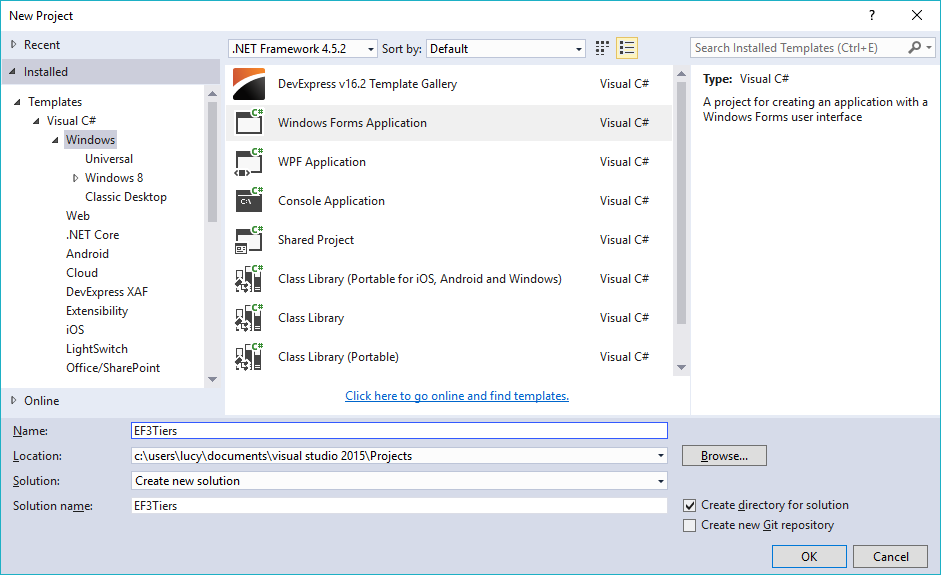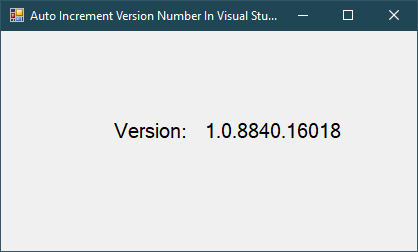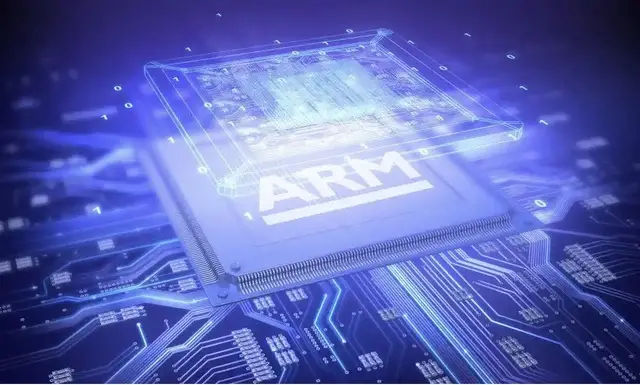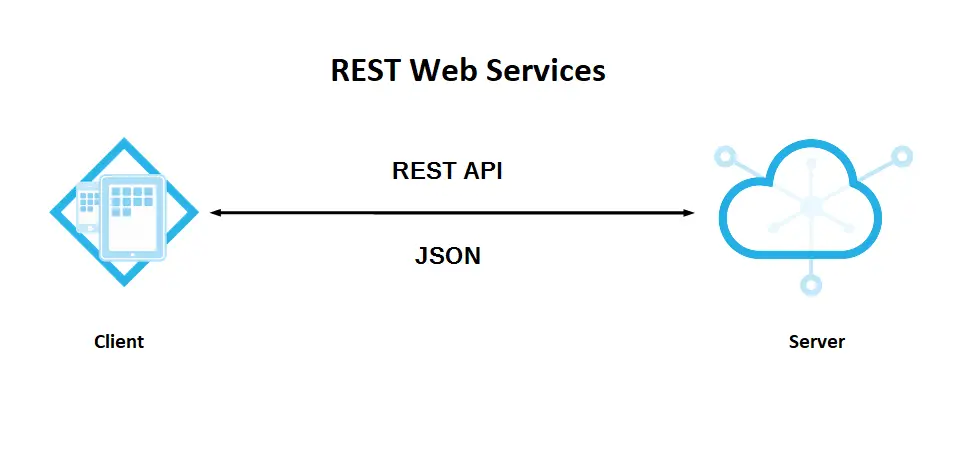Windows Forms: Insert Update Delete View data in SQL Server using 3 Tiers in C#
By FoxLearn 6/25/2017 7:54:21 PM 6.22K
Step 1: Click New Project, then select Visual C# on the left, then Windows and then select Windows Forms Application. Name your project "EF3Tiers" and then click OK
 Select Class Library, then create DataLayer, Model and BusinessLayer project
Select Class Library, then create DataLayer, Model and BusinessLayer project
Step 2: Design your form as below
Form1

frmAddEditContact

Step 3: Create an EF model as below

You should create a Contact table with fileds corespond the contact class
Step 4: Add an interface to DataLayer project
using System;
using System.Collections.Generic;
using System.Linq;
using System.Text;
using System.Threading.Tasks;
using Model;
namespace DataLayer
{
public interface IContactRepository
{
List<Contact> GetAll();
Contact GetById(int id);
Contact Insert(Contact obj);
void Update(Contact obj);
void Delete(Contact obj);
}
}Create a ContactRepository class to handle access database
using System;
using System.Collections.Generic;
using System.Linq;
using System.Text;
using System.Threading.Tasks;
using Model;
namespace DataLayer
{
public class ContactRepository : IContactRepository
{
public void Delete(Contact obj)
{
using(ContactEntities db = new ContactEntities())
{
db.Contacts.Attach(obj);
db.Contacts.Remove(obj);
db.SaveChanges();
}
}
public List<Contact> GetAll()
{
using (ContactEntities db = new ContactEntities())
{
return db.Contacts.ToList();
}
}
public Contact GetById(int id)
{
using (ContactEntities db = new ContactEntities())
{
return db.Contacts.Find(id);
}
}
public Contact Insert(Contact obj)
{
using (ContactEntities db = new ContactEntities())
{
db.Contacts.Add(obj);
db.SaveChanges();
return obj;
}
}
public void Update(Contact obj)
{
using (ContactEntities db = new ContactEntities())
{
db.Contacts.Attach(obj);
db.Entry(obj).State = System.Data.Entity.EntityState.Modified;
db.SaveChanges();
}
}
}
}Step 5: Add a ContactServices to BusinessLayer project
using System;
using System.Collections.Generic;
using System.Linq;
using System.Text;
using System.Threading.Tasks;
using DataLayer;
using Model;
namespace BusinessLayer
{
public static class ContactServices
{
static IContactRepository repository;
static ContactServices()
{
repository = new ContactRepository();
}
public static List<Contact> GetAll()
{
return repository.GetAll();
}
public static Contact GetById(int id)
{
return repository.GetById(id);
}
public static Contact Insert(Contact obj)
{
return repository.Insert(obj);
}
public static void Update(Contact obj)
{
repository.Update(obj);
}
public static void Delete(Contact obj)
{
repository.Delete(obj);
}
}
}You can easily change code in business layer, don't need modify code in UI
Step 6: Add code to handle your form as below
Form1
using BusinessLayer;
using Model;
using System;
using System.Collections.Generic;
using System.ComponentModel;
using System.Data;
using System.Drawing;
using System.Linq;
using System.Text;
using System.Threading.Tasks;
using System.Windows.Forms;
namespace EF3Tiers
{
public partial class Form1 : Form
{
public Form1()
{
InitializeComponent();
}
private void Form1_Load(object sender, EventArgs e)
{
//Call business layer to get data
contactBindingSource.DataSource = ContactServices.GetAll();
}
private void btnAdd_Click(object sender, EventArgs e)
{
using(frmAddEditContact frm =new frmAddEditContact(null))
{
if (frm.ShowDialog() == DialogResult.OK)
contactBindingSource.DataSource = ContactServices.GetAll();
}
}
private void btnEdit_Click(object sender, EventArgs e)
{
if (contactBindingSource.Current == null)
return;
using (frmAddEditContact frm = new frmAddEditContact(contactBindingSource.Current as Contact))
{
if (frm.ShowDialog() == DialogResult.OK)
contactBindingSource.DataSource = ContactServices.GetAll();
}
}
private void btnDelete_Click(object sender, EventArgs e)
{
if (contactBindingSource.Current == null)
return;
if(MessageBox.Show("Are you sure want to delete this record ?", "Message", MessageBoxButtons.YesNo, MessageBoxIcon.Question) == DialogResult.Yes)
{
ContactServices.Delete(contactBindingSource.Current as Contact);
contactBindingSource.RemoveCurrent();
}
}
}
}frmAddEditContact
using BusinessLayer;
using Model;
using System;
using System.Collections.Generic;
using System.ComponentModel;
using System.Data;
using System.Drawing;
using System.Linq;
using System.Text;
using System.Threading.Tasks;
using System.Windows.Forms;
namespace EF3Tiers
{
public partial class frmAddEditContact : Form
{
bool IsNew;
public frmAddEditContact(Contact obj)
{
InitializeComponent();
if (obj == null)
{
contactBindingSource.DataSource = new Contact();
IsNew = true;
}
else
{
contactBindingSource.DataSource = obj;
IsNew = false;
}
}
private void frmAddEditContact_FormClosing(object sender, FormClosingEventArgs e)
{
if (DialogResult == DialogResult.OK)
{
if (string.IsNullOrEmpty(txtContactName.Text))
{
MessageBox.Show("Please enter your contact name.", "Message", MessageBoxButtons.OK, MessageBoxIcon.Information);
txtContactName.Focus();
e.Cancel = true;
return;
}
if (IsNew)
ContactServices.Insert(contactBindingSource.Current as Contact);
else
ContactServices.Update(contactBindingSource.Current as Contact);
}
}
}
}VIDEO TUTORIALS
- Windows Forms: Insert Update Delete From Database in VB.NET
- Windows Forms: Insert Update Delete Search Records in C# DataGridView
- Windows Forms: Insert Update Delete and View data from SQL Database using ADO.Net in C#
- Windows Forms: Insert Update Delete data in Database from DataGridView in C#
- Windows Forms: Insert Update Delete Search data from local database in C#
- Windows Forms: Insert Update Delete Select in SQL Server in C#
- Windows Forms: Insert Update Delete and View data from SQL Database using NPoco ORM in C#
- Windows Forms: Insert Update Delete View data from SQL Database using 3 Tier Architecture in C#





